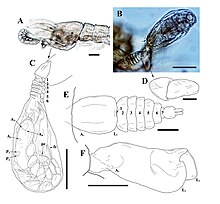Tantulocarida is a highly specialised group of parasitic crustaceans that consists of about 33 species, treated as a class in superclass Multicrustacea. They are typically ectoparasites that infest copepods, isopods, tanaids, amphipods and ostracods.[2][3]
| Tantulocarida | |
|---|---|
 | |
| Microdajus sp. | |
| Scientific classification | |
| Domain: | Eukaryota |
| Kingdom: | Animalia |
| Phylum: | Arthropoda |
| Superclass: | Multicrustacea |
| Class: | Tantulocarida G. A. Boxshall & R. J. Lincoln, 1983 [1] |
| Families | |
Description
Eyes are completely absent.[4]
The tantulus larvae has a head with a ventral oral disc but no appendages, a six-segmented thorax with six pairs of legs, and a limbless abdomen consisting of one to six segments in addition to a telson.[5]
Body length
Members of this subclass are minute – less than 0.3 millimetres (0.012 in) in length and have a dramatic reduction in body form compared to other crustaceans, with an unsegmented, sac-like thorax and a much reduced abdomen.[6] One tantulocarid species, Tantulacus dieteri, is the world's smallest arthropod, with a total body length of only 85 micrometres (0.0033 in).[7]
Life cycle
The tantulocarid life cycle is unique among crustaceans. The tantulus larva transforms directly from a non-feeding (lecithotrophic) and free-swimming organism into a parasite without any instars. When entering the parasitic stage much of the body, such as the muscles, degenerates, even if the body itself becomes bigger. As a parasite it is permanently attached to its host, and after piercing its host's cuticle with an unpaired stylet, a rootlet system used to absorb nutrients enters through the hole and grow into the host’s tissue. The adult form develops inside the larva, and can become either a sac-like parthenogenetic female, or a fully developed free-living, non-feeding and sexually-reproducing male or female.[8][9][10][11][12] The eggs inside the parthenogenetic female are eventually released as fully developed tantulus larvae. The finding of what appears to be a benthic non-feeding nauplius larva suggests that eggs produced by sexual females hatch as nauplii instead of tantulus larvae. Both the parthenogenetic and sexual females are semelparous.[13]
Classification
References
External links
 Data related to Tantulocarida at Wikispecies
Data related to Tantulocarida at Wikispecies
